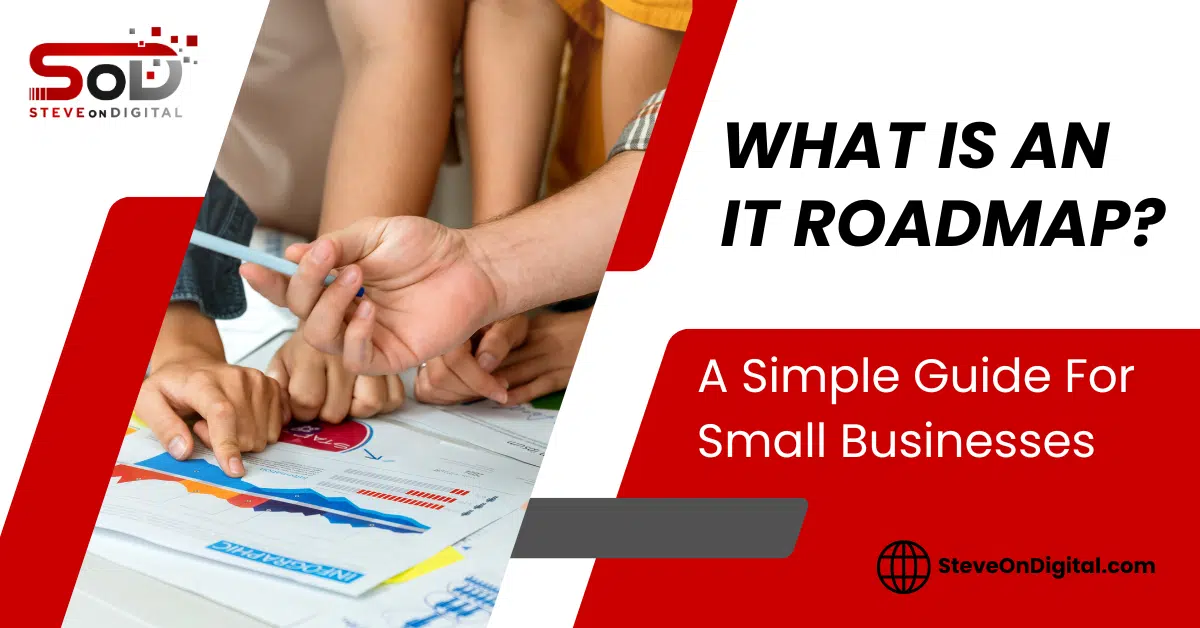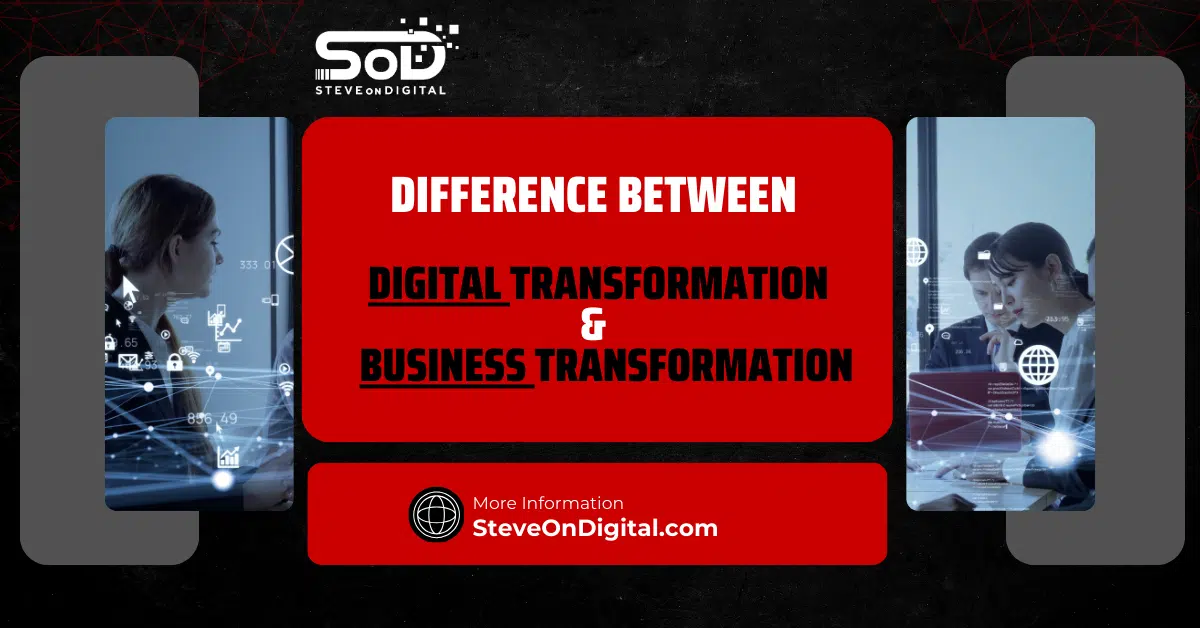An IT roadmap is a strategic plan that outlines the technology solutions and initiatives a business needs to implement to achieve its goals. It acts like a GPS for your company’s technology strategy, guiding you from your current state to your desired future state.
I’m Steve, a digital transformation expert with a strong background in electrical engineering, an MBA, and a master’s in Project Management. I excel at helping SMEs navigate the digital landscape with practical insights. Let’s begin!
In today’s fast-paced technological world, having a clear IT roadmap is crucial for small business owners like us. It ensures that our tech investments support our broader strategic goals, leading to more efficient operations and better returns on investment. This roadmap includes everything from upgrading infrastructure hardware to adopting new technology and integrating systems.
Definition Of An IT Roadmap
An IT roadmap is a strategic plan that outlines the technology solutions and initiatives a business needs to implement to achieve its goals. It’s like a GPS for your company’s technology strategy, guiding you from your current state to your desired future state. An IT roadmap includes everything from upgrading infrastructure hardware to adopting new technology and integrating systems.
| Component | Description |
|---|---|
| Strategic Plan | Outlines technology solutions and initiatives aligned with business goals. |
| Current State | Assessment of existing systems, processes, and infrastructure. |
| Future State | Desired goals and objectives for technology to achieve. |
| Implementation Steps | Specific actions and tasks needed to achieve the desired future state. |
| Stakeholders Involvement | Engagement of relevant stakeholders to ensure buy-in and support throughout the process. |
Purpose Of An IT Roadmap
The primary purpose of an IT roadmap is to align your technology initiatives with your company’s broader strategic goals. This alignment ensures that your tech investments support your business objectives, leading to more efficient operations and a better return on investment. By having a well-defined IT roadmap, you can:
- Prioritize Tasks: Focus on the most critical projects first.
- Set Realistic Timelines: Plan your technology adoption and upgrades without overextending resources.
- Engage Key Stakeholders: Involve relevant stakeholders in the decision-making process, ensuring everyone is on the same page.
| Purpose | Benefits |
|---|---|
| Align Technology Initiatives | Ensures that technology investments and initiatives support and align with business objectives. |
| Prioritize Tasks | Focuses resources on the most critical projects first, optimizing productivity and outcomes. |
| Set Realistic Timelines | Plans technology adoption and upgrades efficiently, avoiding resource overextension. |
| Engage Stakeholders | Involves relevant stakeholders in decision-making, fostering collaboration and buy-in. |
Understanding IT Roadmaps
To truly grasp the concept of an IT roadmap, it’s essential to understand its key components and the various types that exist.
Key Components Of An IT Roadmap
An effective IT roadmap includes several crucial elements:
- Current State Analysis: Assess your existing systems and infrastructure.
- Strategic Objectives: Clearly define what you aim to achieve with your technology initiatives.
- Technology Solutions: Identify the tools, software, and hardware needed.
- Timeline: Set realistic timelines for implementation.
- Key Stakeholders: Involve internal teams and relevant stakeholders in the planning process.
- Risk Factors: Identify potential risks and plan for mitigation.
Types Of IT Roadmaps
There are different types of IT roadmaps, each serving a unique purpose:
- Strategic Roadmap: Focuses on long-term technology goals and how they align with the business strategy.
- Operational Roadmap: Details the day-to-day operations and short-term projects.
- Project-Specific Roadmap: Centers around specific technology projects or initiatives.
Strategic Planning And IT Roadmaps
A well-planned IT roadmap aligns with your business strategy and involves key stakeholders to ensure successful implementation.
Aligning With Business Objectives
Your IT roadmap should always align with your business strategy. This alignment means your tech initiatives support your overall business goals, making every dollar spent on technology count. For example, if your goal is to improve customer service, your IT roadmap might include implementing a new CRM system to manage customer relationships better.
Role Of Key Stakeholders
Involving key stakeholders in the IT roadmap process is crucial. These stakeholders could be your IT team, department heads, or even external consultants. Their input ensures the roadmap is realistic and considers all aspects of your business. When I created my IT roadmap, I made sure to involve my IT director and project managers to get a comprehensive view.
Setting Realistic Timelines
Setting achievable timelines is essential for the success of your IT roadmap. Unrealistic deadlines can lead to rushed implementations and potential failures. Break down your projects into manageable phases and set deadlines that are ambitious yet attainable. For instance, when planning a major system upgrade, I phased the project over six months to ensure minimal disruption to business operations.
Creating An IT Roadmap
Creating an IT roadmap involves several steps, from assessing your current systems to developing a detailed plan.

Initial Assessment And Analysis
Start by evaluating your current IT infrastructure and systems. This assessment helps you understand what you have and what you need. When I began this process, I conducted a thorough review of our existing systems and identified areas that needed improvement or replacement.
Defining Strategic Objectives
Once you have a clear picture of your current state, define your strategic objectives. These objectives should be specific, measurable, achievable, relevant, and time-bound (SMART). For example, one of my strategic objectives was to reduce downtime by 20% within the next year by upgrading our network infrastructure.
Developing The Roadmap
With your objectives in place, you can start developing your roadmap. This process involves:
- Selecting Technology Solutions: Choose the technology that aligns with your objectives.
- Engaging Key Stakeholders: Involve relevant stakeholders in the planning process.
- Creating a Timeline: Develop a realistic timeline for implementation.
- Monitoring Progress: Regularly review and adjust your roadmap as needed.
Implementing An IT Roadmap
Technology Adoption And Integration
Implementing an IT roadmap begins with adopting and integrating the right technology solutions. This process involves several key steps:
- Assessment of Current Systems: Evaluate existing systems to understand their capabilities and limitations. For instance, I once had to assess our legacy systems to determine which could be upgraded and which needed replacement.
- Selection of Technology Solutions: Choose technologies that align with your strategic objectives. When I integrated a new CRM system, I ensured it met our customer relationship management needs.
- Integration Planning: Develop a detailed plan for integrating new technologies with existing systems. This involves mapping out how new software and hardware will work together. During a significant upgrade, I created a step-by-step plan to integrate our new ERP system with minimal disruption.
- Training and Support: Provide training for your team to ensure they can effectively use the new technology. I held several training sessions when we introduced a new project management tool.
Change Management
Managing change is crucial for the successful implementation of an IT roadmap. Here are some strategies that have worked for me:
- Communication: Clearly communicate the changes to all stakeholders. Explain the benefits and how it will impact their work. I found that regular updates and open forums for questions helped ease concerns.
- Involvement of Key Stakeholders: Involve key stakeholders in the planning and implementation phases. Their input can be invaluable. For example, involving department heads early on helped identify potential issues before they became problems.
- Gradual Implementation: Implement changes gradually to allow time for adjustment. When we switched to a new email system, I did it in phases to ensure everyone was comfortable before fully transitioning.
- Support Systems: Establish support systems to help employees adapt to new technologies. I set up a helpdesk specifically for addressing issues related to new technology implementations.
Monitoring Project Progress
Tracking and reporting the progress of IT initiatives are vital for ensuring the success of your IT roadmap:
- Regular Updates: Schedule regular progress meetings to review the status of ongoing projects. I found weekly check-ins effective for keeping everyone aligned.
- Use of Project Management Tools: Utilize project management software to track progress and identify any delays or issues. Tools like Asana or Trello have been game-changers for me.
- Feedback Mechanisms: Implement feedback mechanisms to gather input from users. This helps in making necessary adjustments. For instance, after rolling out a new internal communication tool, I collected feedback to make improvements based on user experiences.
Key Elements Of A Successful IT Roadmap
Strategic Alignment
Ensuring that your IT roadmap supports the overall strategic direction of your organization is crucial:
- Alignment with Business Goals: Make sure every technology initiative aligns with your company’s broader strategic goals. I always check that our IT projects support our business objectives, like increasing efficiency or enhancing customer service.
- Engagement of Leadership: Involve leadership in the roadmap planning to ensure their support and alignment with business strategy. Regular updates to our executive team have been essential in gaining their buy-in.
Efficient Operations
A well-crafted IT roadmap should lead to more efficient business operations:
- Process Optimization: Use technology to streamline processes and reduce manual tasks. Implementing automation tools in our accounting department saved us countless hours of manual work.
- Improved Communication: Enhance communication within your organization with collaborative tools. The introduction of Slack improved our internal communication significantly.
- Resource Allocation: Efficiently allocate resources based on the roadmap to avoid wastage. Proper planning allowed me to allocate budget and personnel effectively.
Risk Management
Identifying and mitigating potential risks is a critical part of any IT roadmap:
- Risk Assessment: Conduct a thorough risk assessment to identify potential issues. Before implementing a major system upgrade, I assessed all possible risks to prepare adequately.
- Mitigation Strategies: Develop strategies to mitigate identified risks. For instance, we created backup plans for potential data loss scenarios during our migration to a new server.
- Continuous Monitoring: Regularly monitor risks throughout the implementation phase. Continuous oversight helped me catch and address issues early.
Examples Of IT Roadmaps
Case Studies
Providing real-world examples can help illustrate the effectiveness of an IT roadmap. Here are a few examples:
- Case Study 1: A retail company implemented an IT roadmap to integrate their online and offline sales channels, resulting in a 30% increase in overall sales.
- Case Study 2: A healthcare provider used an IT roadmap to upgrade their patient management system, improving patient satisfaction by 25%.
- Case Study 3: A financial services firm adopted a strategic roadmap to enhance their cybersecurity measures, reducing security incidents by 40%.
Roadmap Example
A detailed example of a comprehensive IT roadmap:
- Assessment Phase: Evaluate current IT infrastructure and identify gaps.
- Planning Phase: Define strategic objectives and select appropriate technology solutions.
- Implementation Phase: Integrate new technologies, manage change, and monitor progress.
- Review Phase: Regularly review and update the roadmap to ensure ongoing alignment with business goals.
Technology Roadmaps
What Is A Technology Roadmap?
A technology roadmap is a strategic plan that outlines the technology initiatives an organization needs to implement to achieve its long-term goals. It’s a tool that helps businesses plan for technological advancements and ensure their technology strategy aligns with their business strategy.
Key Elements Of Technology Roadmaps
Major components involved in technology roadmaps include:
- Current State Analysis: Evaluate the existing technology landscape.
- Future Vision: Define the desired future state of technology in the organization.
- Technology Initiatives: Identify specific projects and initiatives to bridge the gap between the current state and future vision.
- Timeline: Establish a timeline for implementing technology initiatives.
- Stakeholder Involvement: Engage key stakeholders throughout the process.
Technology Roadmapping Process
The process of creating a technology roadmap involves several steps:
- Initial Assessment: Conduct a thorough assessment of current technology.
- Vision Development: Develop a clear vision of the future technology landscape.
- Strategic Planning: Plan the strategic initiatives needed to achieve the future vision.
- Implementation Planning: Create a detailed implementation plan, including timelines and resource allocation.
- Review and Adjust: Regularly review and adjust the roadmap to reflect changes in technology and business strategy.
Integrating IT And Technology Roadmaps
Creating an effective IT roadmap requires integrating it with technology roadmaps. This integration helps streamline processes and align technological initiatives with business goals.
Coordination Between IT And Technology Strategies
Integrating IT and technology roadmaps is crucial for ensuring that your tech initiatives support your company’s broader strategic goals. This coordination helps avoid redundancy and ensures that every technology project is aligned with your business strategy. For instance, when I planned to upgrade our CRM system, I coordinated it with our overall IT strategy to enhance customer relationship management effectively.
Cross-functional Collaboration
Successful roadmap development and implementation require cross-functional collaboration. Different teams, such as IT, marketing, and operations, need to work together to ensure the roadmap covers all aspects of the business. I always involve key stakeholders from various departments to get a comprehensive view and ensure everyone is on the same page. This collaboration helps in identifying potential challenges early and finding effective solutions.
Tools And Software For Roadmapping
Using the right tools and software can make creating and managing IT and technology roadmaps much more manageable.
Popular Roadmap Tools
Several tools can help you create effective IT and technology roadmaps. Some popular ones include:
- Aha!: A robust tool for product roadmap planning.
- Jira: Excellent for project management and tracking.
- Asana: Great for managing tasks and projects across teams.
I have personally used Aha! for its comprehensive features that help in visualizing our product roadmap and aligning it with our business strategy.
Selecting The Right Tool
Choosing the best roadmap software depends on your organization’s specific needs. Here are some criteria to consider:
- Ease of Use: The tool should be user-friendly.
- Integration Capabilities: It should integrate well with your existing systems.
- Customizability: The ability to customize the tool to fit your unique requirements.
- Scalability: Ensure the tool can scale as your business grows.
When I selected our roadmap tool, I prioritized ease of use and integration capabilities to ensure a smooth adoption process.
Strategic Initiatives And IT Roadmaps
Identifying and implementing strategic initiatives is a crucial part of developing an IT roadmap.

Identifying Strategic Initiatives
To identify strategic initiatives, start by aligning them with your business objectives. Consider what you need to achieve and how technology can help. For example, one of my strategic initiatives was to improve our data analytics capabilities to better understand customer behavior. This initiative was directly aligned with our goal of enhancing customer satisfaction.
Implementing Strategic Plans
Once you have identified your strategic initiatives, the next step is to implement them. Here’s how:
- Detailed Planning: Break down each initiative into actionable steps.
- Resource Allocation: Allocate necessary resources, including budget and personnel.
- Timeline Setting: Set realistic timelines for each phase of the implementation.
For instance, when implementing our data analytics initiative, I created a detailed plan that included upgrading our software systems, training our staff, and setting a timeline for completion.
Challenges In IT Roadmap Development
Developing an IT roadmap comes with its own set of challenges. Recognizing these challenges early can help in finding effective solutions.
| Challenge | Solution |
|---|---|
| Lack of Clear Objectives | Define specific, measurable, achievable, relevant, and time-bound (SMART) goals. |
| Resistance to Change | Communicate the benefits of transformation, provide comprehensive training and support. |
| Resource Constraints | Prioritize projects based on strategic importance, allocate budget and personnel efficiently. |
Common Challenges
Some common obstacles faced during IT roadmap development include:
- Lack of Clear Objectives: Without clear objectives, it’s challenging to create an effective roadmap.
- Resistance to Change: Employees may resist changes in technology.
- Resource Constraints: Limited resources can hinder the implementation of the roadmap.
I faced resistance to change when we first introduced a new project management tool. Some team members were hesitant to adopt the new system.
Solutions And Best Practices
Here are some practical solutions and best practices to overcome these challenges:
- Clear Communication: Communicate the benefits of the IT roadmap to all stakeholders.
- Training Programs: Provide training to help employees adapt to new technologies.
- Phased Implementation: Implement changes gradually to allow time for adjustment.
In my experience, clear communication and providing comprehensive training helped overcome resistance to adopting our new project management tool.
Final Thoughts
Summarizing The Importance Of An IT Roadmap
An IT roadmap is essential for aligning your technology initiatives with your business goals. It helps prioritize tasks, set realistic timelines, and involve key stakeholders in the decision-making process. By following a well-defined IT roadmap, you can ensure that your tech investments support your business strategy, leading to more efficient operations and better returns.
Future Trends
Looking ahead, several trends are likely to shape the future of IT roadmapping:
- AI and Machine Learning: These technologies will play a significant role in predictive analysis and decision-making.
- Increased Focus on Cybersecurity: As cyber threats evolve, integrating robust cybersecurity measures into IT roadmaps will become increasingly important.
- Greater Emphasis on Sustainability: Businesses will focus more on sustainable technology solutions.
By staying informed about these trends and incorporating them into your IT roadmap, you can ensure your business remains competitive and prepared for future challenges.
In conclusion, an IT roadmap is a powerful tool that helps small business owners like us navigate the complex technology landscape. By understanding its components, managing change effectively, and involving key stakeholders, we can create a roadmap that drives our business forward. Real-world examples and case studies can provide valuable insights and inspiration for developing your own IT roadmap.




